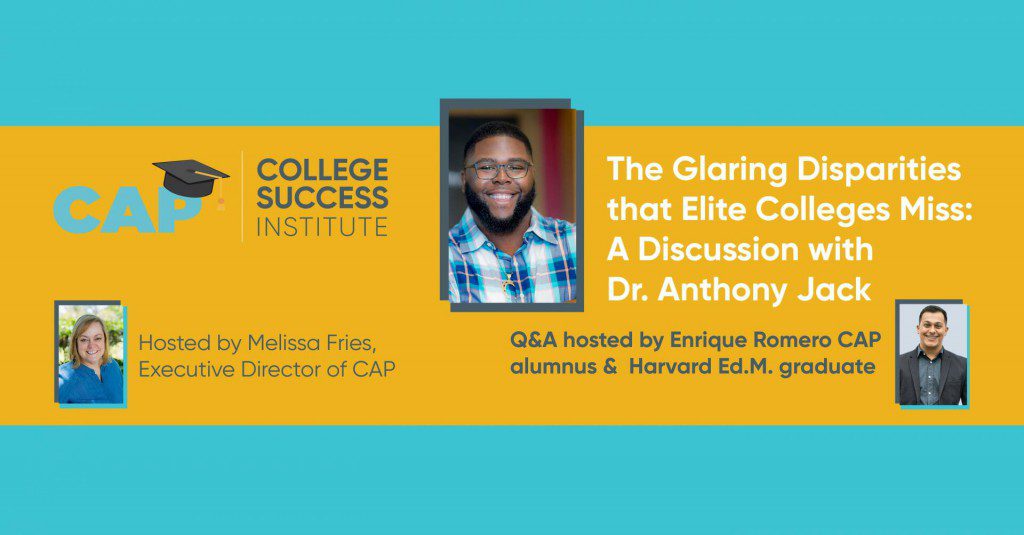
The Glaring Disparities that Elite Colleges Miss: A Discussion with Dr. Anthony Jack
by Marilyn Harris
In a recent online talk that reached more than 100 members of the Making Waves community, including college access and success partners and donors, Dr. Anthony Abraham Jack discussed the barriers that first-generation, low-income students face when they arrive at highly selective colleges and universities. Jack, assistant professor of education at Harvard’s Graduate School of Education, was introduced by Melissa Fries, Executive Director of Making Waves Foundation’s CAP college success program, and after his speech questioned by Enrique Romero, a CAP alumnus who recently completed his master’s degree at Harvard’s Graduate School of Education.
For his talk, Jack drew on his latest book, The Privileged Poor: How Elite Colleges are Failing Disadvantaged Students, in which student voices are heard directly in one-on-one conversations with him. The book illustrates the power of listening to students’ experiences. This approach shaped the CAP team’s strategy of mapping student journeys to understand the community college and four-year college student experience.
Despite institutions’ good intentions, Jack said, student populations at even the most progressive, well-meaning colleges are “depressingly unequal and highly stratified” and generally fail to recognize and address how this leaves those from the lowest economic strata at sea once they arrive on campus.
The phenomenon is deeply personal for Jack. “It’s not just what I studied, it’s what I lived,” he said. As an underprivileged kid from Florida, Jack was one of the lucky few who won scholarships, first to a prestigious local private high school for his senior year, and, from there, to Amherst College. His bus ride north to begin his college experience delivered him to a world he’d never fully anticipated.
His Amherst classmates spoke of high school graduation trips to Europe or season tickets to sporting events, whether – and here was the biggest surprise, he said – they were Black, Latinx, or Native American. That’s when it began to hit him: students of privilege could be any color, but what they had in common was their privilege – family wealth or scholarship-funded college preparation at elite high schools. When he began his graduate research, “This was my ‘pebble in the shoe’ type of moment. I was pissed off about how colleges treated low-income students.”
Jack admitted that in one sense he qualified as one of those privileged students, if barely, because he had had a year at private school. His research would later reveal that at competitive colleges, only 14 percent of the student body come from the bottom half of the US income distribution. He called out Washington University in St. Louis as an example, where students from the top 1 percent of the income scale outnumber those from the lowest by a factor of 4:1. As these sorts of disparities began to dawn on him, he said, “I set out to trouble the waters.”
More support can make the difference
When low-income, first-generation students arrive at university from often poorly resourced public schools, they are “doubly disadvantaged,” Jack explained. The problem isn’t just that they can’t join in their peers’ leisure chitchat, as intimidating and off-putting as that is. Coming from high schools with 30 or more kids in a classroom, they likely lack the opportunity to interact with their teachers and potential mentors and develop the skill or ease needed to nurture those important relationships, which can be critical to college success.
Mentors who broker the student’s transition to and through college are “the most valuable” element in the student’s ultimate success, Jack asserted. Summer internships are an example of how valuable such mentoring can be: “I want the family to understand the difference between working at Target and working at Target headquarters.”
Even those universities that have made gains in achieving diversity, Jack pointed out, have taken the easy route. Rather than recruiting from public schools in low-income areas and doing the hard work to help those students succeed, they disproportionately draw from their “old sources” – private schools.
Financial support for both visible and invisible costs is also key, as CAP has recognized. Full financial aid typically covers only 65 percent of true college expenses, he said. “It’s disgusting that some students with full rides have to sleep in their cars.” As for spring break, when dining halls shut down and most students either head home or to Vail or Cancun, the doubly disadvantaged must scrounge for food – “the real ‘Hunger Games,’” as one student put it.
To make real progress, colleges must invest far more in housing, food, and professional development as well as enhanced mental health services for the least privileged students, Jack said. And what is the one thing he would change about the student experience, Enrique Romero asked. “I would get them to learn the importance of asking for help and of enlisting others to help with their success story.”
Disclaimer:
The opinions expressed in this article series are those of the featured contributors. They are not meant to reflect the opinions or views of Making Waves Foundation.
